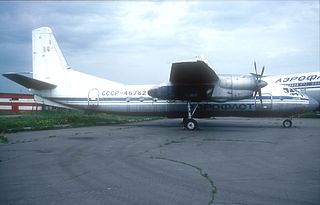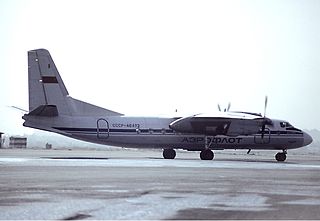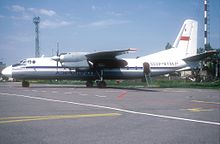
The Antonov An-10 Ukraina is a four-engined turboprop passenger transport aircraft designed in the Soviet Union.

Polar Airlines is an airline based in Yakutsk, Sakha Republic, Russia. It operates scheduled and charter passenger and cargo services. In 2022, it became part of Russia's single far-eastern airline, along with four other airlines.

Progress Multi Trade Air Flight 241 was a scheduled domestic passenger flight from Siem Reap to Sihanoukville, Cambodia. The flight was operated by regional airliner PMTair using an Antonov An-24. On 25 June 2007, the Antonov An-24, registered as XU-U4A, disappeared over the Cambodian jungle near Bokor Mountain in Kampot while on approach to Sihanoukville. A massive search and rescue operation ensued with thousands of soldiers and police scoured the area. The aircraft was found to have crashed in southwestern Cambodia, northeast of Dâmrei Mountains. All 22 people on board, most of whom were South Korean tourists, were killed. It remains as the second deadliest air disaster in Cambodian history.

Aeroflot-Nord Flight 821 was a scheduled domestic passenger flight operated by Aeroflot-Nord in a service agreement with Aeroflot and as its subsidiary. On 14 September 2008, the aircraft operating the flight crashed on approach to Perm International Airport at 5:10 local time (UTC+06). All 82 passengers and six crew members were killed. Among the passengers who were killed was Russian Colonel General Gennady Troshev, an adviser to the President of Russia who had been the commander of the North Caucasus Military District during the Second Chechen War. A section of the Trans-Siberian Railway was damaged by the crash. Flight 821 is the deadliest accident involving a Boeing 737-500, surpassing the 1993 crash of Asiana Airlines Flight 733, and was the second-deadliest aviation accident of 2008, behind Spanair Flight 5022.

On 11 August 1979, a mid-air collision occurred over the Ukrainian SSR, near the city of Dniprodzerzhynsk. The aircraft involved were both Tupolev Tu-134As on scheduled domestic passenger flights, operated by Aeroflot. All 178 people aboard both aircraft died in the accident.

On 11 November 2010, an Antonov An-24 passenger aircraft of Tarco Air on a domestic service from Khartoum to Zalingei, Sudan, crashed on landing at Zalingei Airport, bursting into flames on the runway. Two passengers died, although reports on the number of fatalities varied from one to six.

The 1976 Anapa mid-air collision was the collision of Aeroflot Flight 7957 and Aeroflot Flight S-31 on 9 September 1976, off the coast of Anapa in the Soviet Union. All 70 people on the two aircraft were killed in the crash. The primary cause of the accident was determined to be error by the air traffic controller; investigators never recovered the fuselage of the Yak-40.

Aeroflot Flight 5003 was a Soviet domestic cargo flight that crashed during climb out on 14 January 1967. The Antonov An-12B was flying between Novosibirsk and Krasnoyarsk in Russia with a crew of six when it crashed. It was carrying industrial parts from Moscow to Khabarovsk with several intermediate stops in between, however it caught fire shortly after takeoff, resulting in a fatal accident. At the time Flight 5003 was being operated by Polar Aviation Management under Aeroflot.

Aeroflot Flight A-13 was a scheduled Soviet domestic passenger flight from Baku, Azerbaijan to Fort-Shevchenko in Kazakhstan that crashed on 18 August 1973 shortly after takeoff killing 56 of the 64 passengers and crew aboard. The Antonov An-24 had suffered an engine failure on takeoff and was attempting to return to the airport when it struck an oil rig cable at low altitude resulting in a crash. At the time, it was the second deadliest accident involving the An-24 and remains the second deadliest aviation accident in Azerbaijani history. The engine failure had been caused by the effect of continuous overheating on the performance of the blades.

On Sunday 3 August 1969 an Antonov An-24 operating Aeroflot Flight N-826 crashed resulting in the death of all 55 people on board. An investigation revealed the cause of the accident was an in flight failure of the propeller attached to "No. 1" (left) engine.

Aeroflot Flight L-51 was a scheduled domestic passenger flight operated by an Antonov An-24 that crashed on approach to Liepāja International Airport on 30 December 1967, resulting in the death of 43 of the 51 people on board. To date, it is the deadliest aviation accident in Latvian history. The investigation revealed the cause of the accident to be pilot error.

Aeroflot Flight 2174 was a scheduled domestic passenger flight operated by an Antonov An-24B that crashed on approach to Saratov Tsentralny Airport on Wednesday 1 December 1971, resulting in the death of all 57 people on board. An investigation revealed the aircraft entered icing conditions leading to a loss of control.

Aeroflot Flight U-45 was a passenger flight operated by an Ilyushin Il-18 that crashed during the approach to Samarkand on Friday, 6 February 1970, resulting in the death of 92 of the 106 people on board. An investigation revealed the aircraft went below the minimum obstacle clearance altitude (MOCA) during approach to Samarkand International Airport.

Aeroflot Flight 1661 was a passenger flight operated by an Antonov An-24 that crashed during its initial climb, 25 minutes after take-off from Tolmachevo Airport on 1 April 1970. All 45 people on board perished. An investigation revealed that the Antonov collided with a radiosonde, causing a loss of control.

Aeroflot Flight N-36 was a scheduled domestic Aeroflot passenger flight from Chernivtsi International Airport to Zhuliany Airport, Ukrainian Soviet Socialist Republic that crashed on 17 December 1976 near Kiev Airport, resulting in 48 fatalities and 7 survivors.

Aeroflot Flight 6263 was a scheduled domestic passenger flight from Krasnodar International Airport to Perm International Airport, with stopovers in Volgograd, Saratov, and Kazan. Shortly before the flight was scheduled to land in Perm on 21 January 1973, the aircraft entered a downward spiral and crashed in Bolshesosnovsky District approximately 91 km from Perm International Airport, its intended destination. Of the 39 passengers and crew on board the aircraft, four survived the initial crash; however, all survivors had died by the time rescuers arrived at the scene.

Aeroflot Flight 3630 was a regularly scheduled passenger flight operated by Aeroflot from Mineralnye Vody Airport to Vilnius Airport with a stop over at Rostov-on-Don Airport. On 2 September 1970, the Tu-124 operating this flight crashed after a loss of control at cruise altitude, 42 minutes after takeoff from Rostov-on-Don Airport. All 32 passengers and five crew members were killed.

The 1981 Zheleznogorsk mid-air collision was an accident involving a Yakovlev Yak-40 jet and a Mil Mi-8T helicopter, both operated by the Russian airline Aeroflot, 11 km east of Zheleznogorsk-Ilimskiy Airport, Soviet Union, on 18 September 1981. None of the combined 40 passengers and crew on either aircraft survived.

The Aeroflot Flight H-75 was an aviation accident involving an Antonov An-24B aircraft operated by the Kiev United Aviation Squadron (Aeroflot), which occurred on Sunday, January 6, 1974, near Mukachevo, resulting in the deaths of all 24 people on board.
















